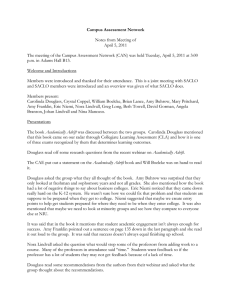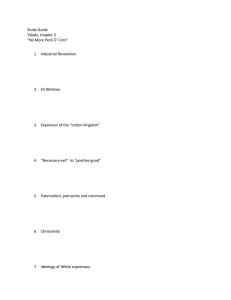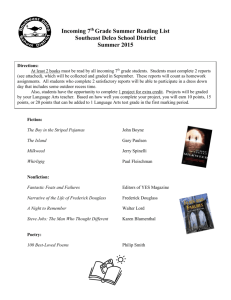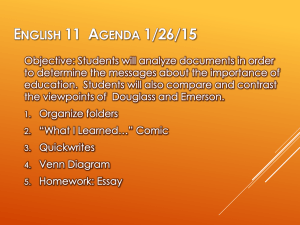Campus Assessment Network Notes from Meeting of April 11, 2012
advertisement
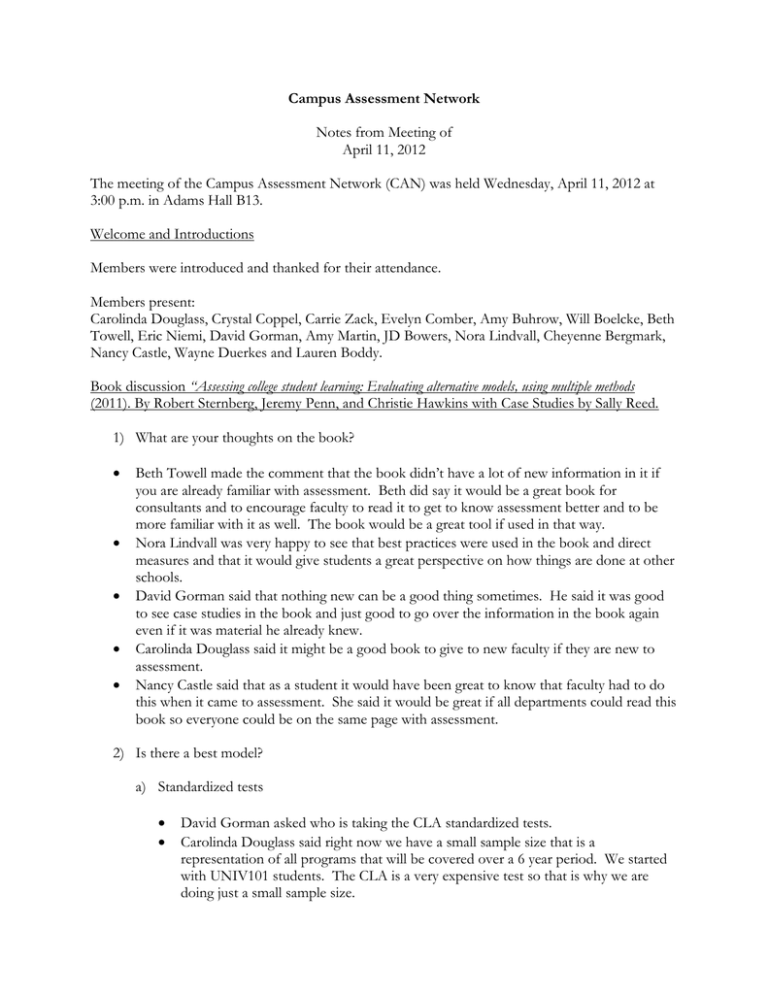
Campus Assessment Network Notes from Meeting of April 11, 2012 The meeting of the Campus Assessment Network (CAN) was held Wednesday, April 11, 2012 at 3:00 p.m. in Adams Hall B13. Welcome and Introductions Members were introduced and thanked for their attendance. Members present: Carolinda Douglass, Crystal Coppel, Carrie Zack, Evelyn Comber, Amy Buhrow, Will Boelcke, Beth Towell, Eric Niemi, David Gorman, Amy Martin, JD Bowers, Nora Lindvall, Cheyenne Bergmark, Nancy Castle, Wayne Duerkes and Lauren Boddy. Book discussion “Assessing college student learning: Evaluating alternative models, using multiple methods (2011). By Robert Sternberg, Jeremy Penn, and Christie Hawkins with Case Studies by Sally Reed. 1) What are your thoughts on the book? Beth Towell made the comment that the book didn’t have a lot of new information in it if you are already familiar with assessment. Beth did say it would be a great book for consultants and to encourage faculty to read it to get to know assessment better and to be more familiar with it as well. The book would be a great tool if used in that way. Nora Lindvall was very happy to see that best practices were used in the book and direct measures and that it would give students a great perspective on how things are done at other schools. David Gorman said that nothing new can be a good thing sometimes. He said it was good to see case studies in the book and just good to go over the information in the book again even if it was material he already knew. Carolinda Douglass said it might be a good book to give to new faculty if they are new to assessment. Nancy Castle said that as a student it would have been great to know that faculty had to do this when it came to assessment. She said it would be great if all departments could read this book so everyone could be on the same page with assessment. 2) Is there a best model? a) Standardized tests David Gorman asked who is taking the CLA standardized tests. Carolinda Douglass said right now we have a small sample size that is a representation of all programs that will be covered over a 6 year period. We started with UNIV101 students. The CLA is a very expensive test so that is why we are doing just a small sample size. Amy Buhrow said that her area did the ETS major field exam in business a few years ago and the faculty reviewed the test. It was great to see how we lined up with the test and it was a great conversation tool. Amy said her area decided not to do the test every year and that they are going to look at it again in five years. But just to start the conversation of what we think is important has been a great exercise. Beth Towell said that standardized testing is not always the best tool to use when it comes to assessment. Nora Lindvall said her experience with standardized testing has only been that is has been administered to her. She was curious about how relevant it is when it comes to higher education. Carolinda Douglass responded to Nora Lindvall by saying that VSA has 3 tests to use and you must use one of them. There is the CLA, ETSP Profile and the CAAP. NIU uses the CLA test. The CAAP would only come back to us in hard copy form and the ETS doesn’t fit our school and our peers as it seems to be more for smaller schools. Beth Towell said that of course it is great to be able to say you are doing fine in your area. But it is just as important to find out what areas you are not doing fine in so you can improve and maybe even get grants to help you improve in those areas. Wayne Duerkes asked that if there is an area of NIU that does have dismal test results how is NIU reacting to that and what are they doing to improve that. Carolinda Douglass responded to Wayne by saying that these are very global measures and that you have to present the data and ask what are you going to do about this as a campus. If it is just data from a standardized test it can be hard to figure out exactly what you are going to do because it can be hard to pin point exactly what the problem is and what area it really is in. Many students may not be motivated to take standardized tests, so that may be why scores are low sometimes. Benchmarks and trends are the best we can get from standardized testing. It is very valuable to be able to hear from students and what they want out of standardized tests. NIU is trying to make the tests course required. Something like that is easier to sell to freshman that is it to sell to seniors. Wayne Duerkes asked if professors here would feel that they would need to teach to the test so students would know the material for the test or would they just teach as normal. Carolinda Douglass responded by saying that from what she has heard from professors, they don’t feel the pressure or the need to have to teach to the test. David Gorman said that standardized testing is going to work less and less well the higher you go up in education especially once you get to graduate school. But it might be a good thing to build into general education classes. b) Indirect measures Carolinda Douglass said that NIU participates in the NSEE and said that NSEE is an indirect measure. There is an assumption that if you are engaged then you will learn more but that is a big leap. Another indirect method we use at NIU is the alumni surveys. We have one year out for undergraduates and graduates and we also have a 5 and 9 year out for undergraduates. Carrie Zack said that her department uses an exit survey. At the end of the student teaching semester they ask students to take the survey to get a sense of how prepared they feel they were to meet each of the Illinois teaching standards. Their cooperating teachers that they are working with in the classroom also take the survey as well as their supervisors from NIU that go and see them in the classroom. It is nice to get a few different viewpoints on how well the students are prepared. Carrie said that students tend to rate themselves the best and their cooperating teachers tend to rate the students the lowest. Amy Buhrow said that each one of her departments in the College of Business has a different combination of placement and exit surveys. c) Portfolios and performance-based assessment David Gorman said that some professors from the English department have their students do portfolios. For some areas of English it is very easy for students to put together portfolios because they are producing very similar products but for others it is more difficult because they are producing all different kinds of products. Carolinda Douglass asked if any of the students have had to put together portfolios for any of their programs and their response was no. Amy Buhrow said that the Marketing department and OMIS have a portfolio project where every student gets a binder at the beginning of their junior year and are asked to put their work products in the binder. For the professors it would be very time consuming to go through all of the binders so, for assessment reasons, they just do a sampling of the portfolio binders. Carolinda Douglass shared a couple of examples of performance based assessment. She mentioned the senior design project from the College of Engineering and Engineering Technology. Students will build or make something their senior year and then present on it. Family and friends will attend but so will people from the field to give them feedback on how well they are doing. Professors will also give feedback as well as peer feedback. Another great performance based assessment is the honors capstone and 81% of our programs have some kind of capstone experience listed. Lauren Boddy said that in Psychology just because someone is taking a research methods Psychology class doesn’t mean they are going to go into research. Not all Psychology majors want to do that. The class is required so how can that be a good way to assess whether or not a Psychology major wants to go into research or not? Carolinda Douglass responded by saying that a few years down the road you can see which of the students that took that class decided to go into research. But immediately you can look to the students outcomes and try and see what are they expecting in that course? You may not come out of that course as a researcher but you may come out with some fundamental piece of the building blocks that would lead you on that path if that is what you choose to do. Eric Niemi said that he uses a modification of Brookfield’s Critical Incodent Questionnaire. At the end of class he asks the class about 5 questions and it has been a great tool to anonymously collect data. Carolinda Douglass asked the students if any of their professors have ever asked them to do some sort of a midterm evaluation the semester. Have any of your professors ever asked you assessment type questions? Like how are things going, how am I doing, what can be done differently or better, or what could you do differently? Eric Niemi said that he has asked his students those questions but he said and the other students agreed that their professors have never asked them those questions. Wayne Duerkes said that it would be nice to be asked that. He said that even as a student it isn’t always easy to tell what the objectives are for the class. He said the professors never bring it up or even go over it during the class over the whole semester. He said it would be really nice if professors went over the objectives in depth so as we are doing work in the class over the semester we have a really good idea of what they are looking for. Wayne said he will go to his professors before the semester starts and talk to them one on one about what the objectives are for the class. He said they are always very willing to talk about them with him when he asks about it. Lauren Broddy said that the objectives are never revisited in any of her classes. But if someone was to ask about them, then the professor will go over them. She said she wishes the professors would take the initiative to go over them with the class especially before midterms or finals. JD Bowers said that not all colleges promote that professors need to do objectives and evaluations because it has no weight on becoming tenure. Your tenure and promotion is mainly based on research. Carolinda Douglass said sometimes there is not a lot of incentive especially when it comes to merit. Especially when merit is only 1-2% or less. Amy Buhrow asked how can you separate course and faculty evaluation from assessing student learning. Carolinda Douglass passed around a book called L.E.A.P. (Liberal Education Americas Promise) where V.A.L.U.E. (Valid Assessment of Learning Undergraduate Education) rubrics are talked about. A page was marked in the book that talks about what the L.E.A.P. essential outcomes are and what it means when they say they are using L.E.A.P. outcomes. 3) Case studies – what is their relevance to assessment at NIU? a) California State University - Sacramento Carolinda Douglass asked the group what they thought about the CSU Sacramento example that was described about in the book? Do you think there is something from that that is relevant or that we should pay attention to here at NIU? They do use L.E.A.P. and when we started the baccalaureate review we started with the L.E.A.P. essential learning outcomes as our starting point. We ended up moving away from that and have since developed the three C’s, Creativity, Communication and Critical Thinking and now we have eight learning outcomes. Vice Provost Anne Birberick has been using these value rubrics as a starting place to help people to start assessing the eight learning outcomes. Beth Towell pointed out that they do their department review every six years and we do ours every eight years. Carolinda Douglass said that it is a Illinois state law for us to do it every eight years. Would it be helpful if we did it more often? David Gorman said that eight years is a long time and we shouldn’t do it any sooner. We have to give information from the past five years so we really get three years off essentially. It is a lot of work to do it which is why we don’t do it more often. b) Duke Carolinda Douglass pointed out that their assessment and program review are tied to their budget. We do give money to some assessment projects through the UAP. c) Miami Dade Carolinda Douglass said that she thought Miami Dade had a really nice example of curricular mapping. Another really nice thing that they do is give free tuition to students who pass a basic skills test and have a “B” or higher average for the first two years. d) St. Olaf College Carolinda Douglass said that she felt like she was looking in a mirror with how the HLC dinged them in 2003 and required a follow up report in 2007 on assessment. We had a similar ding in 2003 and a follow up report on assessment of our Gen Ed. 4) Final thoughts? Lauren Boddy said that it would be helpful if students were introduced to what faculty were all about and what they want to do when it comes to assessment. Even if it is just end of the year evaluations it would give the students a better idea when it comes time to evaluations and what teachers want to hear. Meeting was adjourned at 4:25 pm.
